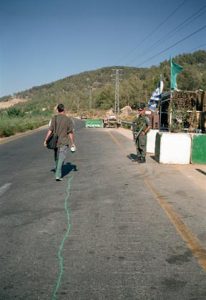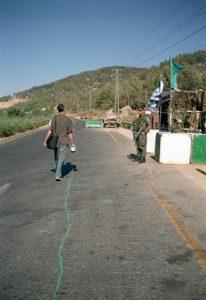Recently I was in England for the glorious wedding of my son in a small Hampshire village’s Registrar’s Office, followed by a lovely garden party on a bright English summer day. And, for another wistful moment, I found my way over the silver “wobbly” bridge, as the locals call it, to the Tate Modern. The sheer grandeur of the old power station transmuted to this massive palace of art is revelation in itself. Knowing that Pure Beauty, John Baldessari’s retrospective, was just there and is now at LACMA, gave the whole visit a kind of piquancy for me.
The Tate had wonderful and extensive shows, one a Francis Alÿs retrospective called A Story of Deception. LACMA’s small but moving taste of Francis Alÿs’ socially committed and deceptively diverse imagination with his Fabiola exhibition, on view last year, and works such as his The Green Line (owned by LACMA, on view in the Tate exhibition) and Gun Camera conditioned me somewhat for the depth of these socially compelling filmed “acts” and the amount of painting and drawing that support this extraordinary artist.

Francis Alÿs, “The Green Line (SOMETIMES DOING SOMETHING POETIC CAN BECOME POLITICAL AND SOMETIMES DOING SOMETHING POLITICAL CAN BECOME POETIC),” 2007, LACMA, purchased with funds provided by the Bernard and Edith Lewin Collection of Mexican Art Deaccession Fund and the Michael and Dorothy Blankfort Bequest by exchange
As one veers from the seemingly absurd to bafflement and tragic profundity, to almost slapstick humor and onto the creation of social myth, and the fixation on ordinary children’s games, one finds this artist disentangling pathos and farce with an indomitable affection. There is mention of “allegorical suggestions,” “absurd expenditure of effort,” and “a precarious optimism in Alÿs’ practice.” For instance, there is Paradox of Prazis, in which Alÿs pushes a large block of ice around the city until it has totally melted. The subtitle of the work is “Sometimes Doing Something Leads to Nothing.” Elsewhere there is the symbolic act of leading sheep around a flagpole, known as Patriotic Tales, or the rather refreshing concept of myth creation by getting 500 Peruvian students in Lima with shovels to dig in small amounts up a giant dune and then down and remain in a straight line throughout in When Faith Moves Mountains. Afterward, in spite of the dust and heat, many claimed that as a result there was a strange and exhilarating feeling of achievement that they were surely to pass on.

Francis Alÿs in collaboration with Cuauhtémoc Medina and Rafael Ortega, still from “When Faith moves Mountains (Cuando la fe mueve montañes),” Lima, 2002, private collection, © Francis Alÿs
Probably the most unusual and strangest of them all, Tornado, sees the artist runs into a fairly large dust tornado over and over, later to be questioned, “Is he recognizing the vanity of poetic gestures at the time of calamity?”
Hylan Booker



